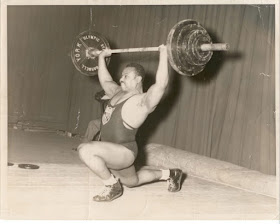 |
| Old-time strongman Abe Boshes built a magnificent physique with a variety of old-school exercises. |
Hail to the Dinosaurs!
Two quick notes and then we'll talk iron.
1. John Grimek Tee Shirts
 |
| If anyone deserves to be on a strongman tee shirt, it's John Grimek. |
John Wood's Magic Shirt Shop for Iron
Slingers (my name for it, not his) has
a new one for you - a John Grimek shirt!
Go here to check it out:
https://www.retrostrength.com/shop/
John also has a bunch of other new
shirts in the works - so you've got
lots to look forward to in 2018!
2. Email Issues
Some of the companies that handle
internet traffic are merging - and that
has thrown email service out of whack
for awhile - so my daily emails may or
may not get through to you.
So please do this as a back-up.
Join the Strength Secrets Facebook Group:
https://www.facebook.com/groups/strengthsecrets/
I post all of my daily emails at the
Dinosaur Training Blog - and then
link to them in posts at the Strength
Secrets page.
So this is a great way to stay up to
date with everything that's happening
at Dino Headquarters.
3. Training With Old Time Barbells
As I mentioned yesterday, old time barbells
were not mass produced.
They were one of a kind pieces made by
local foundries.
They came in all different shapes and
thicknesses.
And many of them were solid pieces of iron -
meaning that they were not adjustable.
So how do you train with that kind of
barbell?
I asked that question, and many of you
responded.
There were two primary suggestions.
1. Use chains to add weight.
That's a good idea, except the old time
barbells ended with a globe on each -
with no bar extending past the globe -
so there was no place to hang a chain
at each end.
So chains wouldn't have worked.
2. Increase Reps, Not Weight.
That's the obvious strategy - but it
doesn't work very well if you have
two or three barbells with big weight
jumps from one to the other.
If you have a 42 pound barbell, a 91
pound barbell and a 147 pound barbell,
it's going to be very tough to advance
from one to the other no matter how
many reps you do with the lighter
barbell. The jumps are just too big.
3. So what's the answer?
I think it's this:
You figure out everything you can do
with each different barbell or dumbbell
(or ring-weight or kettlebell or anything
else) that's available to you.
You include both two hand and single
hand exercises.
You do weightlifting movements with
one or two hands.
You use over grips, under grips and
reverse grips.
You do one legged and two legged
squats.
You do back squats, front squats,
overhead squats and hack squats.
You do flat-footed squats and squats
on your toes.
You do straddle lifts.
You do one arm overhead squats.
You do deadlifts and rowing.
You do presses, push presses and jerks,
using both one hand and two hands.
You do presses - and clean and press -
and clean, squat, press combos.
You do curls and reverse curls.
 |
| World and Olympic champion John Davis got his start by doing dips, pull-ups, handstands, handstand pushups and gymnastics work on the equipment at a local park. |
And you also do leverage movements
such as the crucifix - the rectangular
fix - the barbell front raise - lateral
raises, and many more.
You do exercises where you carry the
weights - such as the farmer's walk.
You see how long you can hold the
weight in a given position.
You do exercises that allow you to use
two or more pieces of equipment at the
same time - such as a combination barbell
lift with one hand and dumbbell lift with
the other hand.
You supplement your barbell training
with bodyweight exercises, gymnastics,
handstands, handstand push-ups, chins,
pull-ups, dips, jumping and sprinting.
You use different rep counts for different
exercises - and do more reps for the easier
exercises and fewer reps for the harder
ones.
 |
| Arthur Saxon using an early type of plate loading barbell. Note how short the bar is! |
In other words, you become very creative.
You learn many different lifts and many
different exercises.
You become good at heavy single rep
lifts - and you also become good at
doubles, triples, fives, sets of 10, and
sets of 20, 40 or 50 reps for leg work.
In short, you become a very well-rounded
strongman.
And frankly, that's a pretty good way to
train - and a pretty good result!
As always, thanks for reading and have
a great day. if you train today, make it
a good one!
Yours in strength,
Brooks Kubik
P.S. For more about old time strongmen
and how they trained, grab these books:
Dinosaur Dumbbell Training
http://www.brookskubik.com/dinosaur_dumbbelltraining.html
Strength, Muscle and Power
http://www.brookskubik.com/strength_muscle_power.html
Dinosaur Training: Lost Secrets of Strength and Development
http://www.brookskubik.com/dinosaur_training.html
P.S. 2. Thought for the Day:
"Necessity is the mother of invention - and a
guide to many fun and effective exercises and
workouts."
- Brooks Kubik
BEFORE YOU LEAVE . . .
We have more than 25 Dinosaur Training books and courses in the Kindle
bookstore - here are several of them - head on over and take a look at the others:












